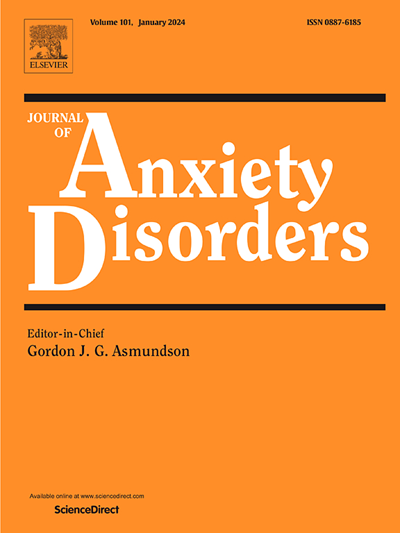Clinician guidance in digital therapeutics for panic disorder: Meta-analytic dissection and implications for regulatory framing and scalable deployment
IF 4.5
2区 医学
Q1 PSYCHIATRY
引用次数: 0
Abstract
Background
Digital therapeutics (DTx) have emerged as scalable and accessible treatment modalities for panic disorder.
Objective
This study aimed to identify the extent to which clinician guidance impacts the digital intervention effectiveness for panic disorder across multiple clinical outcomes.
Methods
This study included 40 randomized controlled trials of digital intervention for panic disorder published up to March 2025. Eligible studies enrolled adults with a primary diagnosis of panic disorder (with or without agoraphobia) and compared a digital therapeutic intervention against active (therapist-led or treatment-as-usual) or passive (waitlist or no-treatment) controls. Outcomes were the Panic Disorder Severity Scale (PDSS), Agoraphobic Cognitions Questionnaire (ACQ), and Body Sensations Questionnaire (BSQ). Random-effects meta-analyses, subgroup analyses, sensitivity analyses, and mixed-effects meta regressions were conducted. The moderator variables included the comparator type, guidance format (clinician-guidance or self-guided), intervention modality, and region.
Results
Self-guided DTx demonstrated a moderate effect size on PDSS (Hedges’ g =0.31, 95 % confidence interval [CI]: 0.05–0.68), whereas clinician-guided interventions exhibited stronger effects (g =0.95, 95 % CI: 0.44–1.46). These findings indicate that well-structured self-guided interventions can address symptom domains, involving panic frequency and physiological distress. Conversely, cognitive-focused outcome assessment using ACQ and BSQ revealed that only clinician-guided interventions yielded statistically significant and clinically meaningful improvements (ACQ: g =0.46, 95 % CI: 0.15–0.76; BSQ: g =0.67, 95 % CI: 0.30–1.05), whereas self-guided formats exhibited negligible effects (ACQ: g =0.11; BSQ: g =0.27).
Conclusions
This meta-analysis revealed that self-guided digital interventions effectively reduce the overall symptom severity in panic disorder, whereas clinician involvement exerts a notably stronger influence on cognition-related outcomes. These findings support a domain-specific and context-sensitive understanding of guidance. Accordingly, the DTx design and policy should match the mechanistic pathways through which psychological change will occur.
惊恐障碍数字治疗的临床医生指导:元分析解剖和对监管框架和可扩展部署的影响。
背景:数字疗法(DTx)已成为可扩展和可获得的恐慌障碍治疗方式。目的:本研究旨在确定临床医生指导在多大程度上影响了惊恐障碍的多种临床结果的数字化干预效果。方法:本研究纳入截至2025年3月发表的40项数字干预惊恐障碍的随机对照试验。符合条件的研究招募了初步诊断为惊恐障碍(有或没有广场恐怖症)的成年人,并将数字治疗干预与主动(治疗师主导或照常治疗)或被动(等候名单或无治疗)对照进行比较。结果为惊恐障碍严重程度量表(PDSS)、广场恐惧症认知问卷(ACQ)和身体感觉问卷(BSQ)。进行随机效应meta分析、亚组分析、敏感性分析和混合效应meta回归。调节变量包括比较者类型、指导形式(临床指导或自我指导)、干预方式和地区。结果:自我引导的DTx对PDSS表现出中等效应(Hedges' g =0.31, 95 %置信区间[CI]: 0.05-0.68),而临床指导的干预表现出更强的效应(g =0.95, 95 % CI: 0.44-1.46)。这些发现表明,结构良好的自我指导干预可以解决症状领域,包括恐慌频率和生理困扰。相反,使用ACQ和BSQ进行的以认知为中心的结果评估显示,只有临床指导的干预才能产生具有统计学意义和临床意义的改善(ACQ: g =0.46, 95 % CI: 0.15-0.76; BSQ: g =0.67, 95 % CI: 0.30-1.05),而自我指导的干预效果可以忽略(ACQ: g =0.11; BSQ: g =0.27)。结论:本荟萃分析显示,自我指导的数字干预有效地降低了恐慌障碍的整体症状严重程度,而临床医生的参与对认知相关结果的影响明显更强。这些发现支持对指导的特定领域和上下文敏感的理解。因此,DTx的设计和政策应该与心理变化发生的机制途径相匹配。
本文章由计算机程序翻译,如有差异,请以英文原文为准。
求助全文
约1分钟内获得全文
求助全文
来源期刊

Journal of Anxiety Disorders
Multiple-
CiteScore
16.60
自引率
2.90%
发文量
95
期刊介绍:
The Journal of Anxiety Disorders is an interdisciplinary journal that publishes research papers on all aspects of anxiety disorders for individuals of all age groups, including children, adolescents, adults, and the elderly. Manuscripts that focus on disorders previously classified as anxiety disorders such as obsessive-compulsive disorder and posttraumatic stress disorder, as well as the new category of illness anxiety disorder, are also within the scope of the journal. The research areas of focus include traditional, behavioral, cognitive, and biological assessment; diagnosis and classification; psychosocial and psychopharmacological treatment; genetics; epidemiology; and prevention. The journal welcomes theoretical and review articles that significantly contribute to current knowledge in the field. It is abstracted and indexed in various databases such as Elsevier, BIOBASE, PubMed/Medline, PsycINFO, BIOSIS Citation Index, BRS Data, Current Contents - Social & Behavioral Sciences, Pascal Francis, Scopus, and Google Scholar.
 求助内容:
求助内容: 应助结果提醒方式:
应助结果提醒方式:


